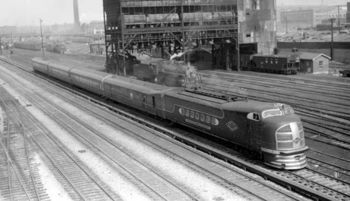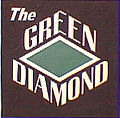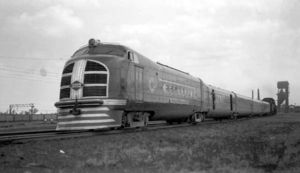Green Diamond


The Green Diamond of the Illinois Central Railroad was a diesel streamliner (IC #121) built in 1936 by Pullman-Standard and powered by General Motors' Electro-Motive Division. It was the last streamliner built with the power car articulated with the train; future streamliners featured a matched but separable locomotive. Its fixed five-car consist was also the end of an era; the popularity of the early streamliners was their undoing, because the trains could not be lengthened or shortened to handle varying loads. The train was painted in a two-tone green livery, "Cypress Green" on the nose and below the window sills with "Cedar Green" above, separated by an aluminum strip. Extensive aluminum trim was applied. The Green Diamond's nickname was the "Tobacco Worm," because of its green color and after the "Tin Worm" nickname of the Union Pacific's first streamliner, the M-10000.
The name was chosen because a green diamond was the Illinois Central's emblem, and because the Diamond Special was the oldest named passenger train on the Chicago, Illinois to St. Louis, Missouri, the route the new train would serve. The name was borne within a diamond on the power car sides.
Equipment used
The train's fixed consist was:
- Power car including driving cab, main engine Winton 201-A 16 cylinder, 1200 hp (890 kW) and generator, auxiliary generator, and train heating boiler. Below the floor, the first truck was powered, but the second, articulated with the second car, was not. A 725 US gallon fuel tank was also mounted between the trucks.
- Storage, Baggage and Mail car of which approximately half was the mail compartment.
- Coach including conductor's office, seating 56.
- Coach including restrooms, seating 60.
- Diner-Lounge-Observation including restrooms, kitchen, dining area seating 8, and observation lounge seating 20.
All passenger-carrying cars were air-conditioned, with radio communication between them. Full width rubber diaphragms joined the cars, and all cars were articulated (sharing a truck with the neighboring car).

In service, the Green Diamond began each morning with an 8:55 AM departure as Train 50 from St. Louis Union Station, arriving at IC's Central Station in Chicago at 1:50 PM. The train was then turned and serviced, for a 5:00 PM return as Train 51, arriving back in St. Louis by 9:55 PM. Seven stops were made en route, and the train ran to a 4 hour 55 minute schedule, being far the fastest of IC's three trains on that route. Wartime in 1943 added an extra 15 minutes to the schedule to cope with traffic congestion, but the train was otherwise unchanged.
On 1946-09-29, with the full dieselization of all Chicago-St.Louis passenger service, the Green Diamond was changed to train Nos. 20 and 21, the reservation requirement was dropped, and the timetable no longer referred to the train as a distinct trainset. Unsurprisingly, the trainset was withdrawn from service on 1947-02-28, being replaced by a new Green Diamond, an E-unit-hauled streamliner with regular lightweight cars.
The trainset was shipped to the ICRR's shops at Paducah, Kentucky, for a complete overhaul, which took two months. The train emerged still in two-tone green, but with the Green Diamond names completely removed. It re-entered service on 1947-04-27, as the Miss-Lou (MISSissippi-LOUisiana) between Jackson, Mississippi, and New Orleans, Louisiana, operating as Trains 27 and 28. It left Jackson at 6:20 AM, arriving in New Orleans at 10:20 AM; the return journey left at 6:20 PM and arrived in Jackson at 10:20 PM.
The trainset was finally retired on August 8, 1950, and sold for scrap.
See also
- Passenger train service on the Illinois Central Railroad
References
- Clifford J. Downey and the Diesel Era staff, Motor Cars, Diamonds and Doodlebugs, Diesel Era Vol.13 #2 (March/April 2002).
- Pinkepank, Jerry A. (1973). The Second Diesel Spotter's Guide. Kalmbach Publishing Co., Milwaukee, WI. ISBN 0-89024-026-4.
Limited production and export locomotives built by EMD | |
|---|---|
| Electrics | SW1200MG · AEM-7 · GM6 · GM10 · GF6C |
| Industrial, military, export and narrow gauge | Model 40 · DDM45 · DHI · GMDH-1 · GMDH-3 · MRS-1 · GA8 · G8 · G12 · G16 · G26 · NF110 · NF210 · JT42CWR (Series 66) · JT42HW-HS · GT46MAC · GT22HW · GT46PAC |
| Streamliners | M-10000 · M-10001 · M-10002 · M-10003-6 · Pioneer Zephyr · General Pershing Zephyr · Green Diamond · Flying Yankee · Aerotrain |
| Experimentals | 1800 hp B-B |
| See also: List of EMD locomotives | |
